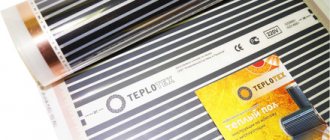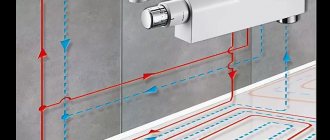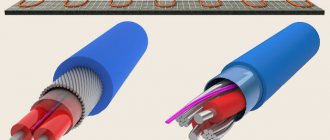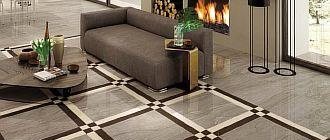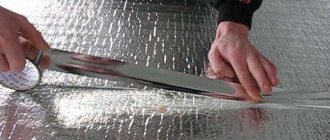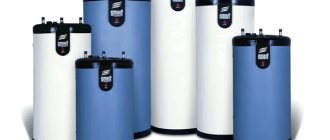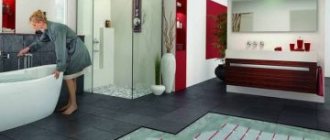The question of installing or altering heating arises before every owner of a house or apartment. Heated floors help increase heating efficiency and reduce utility costs. But can such a system fully replace radiator heating and will the costs of materials and installation be recouped? This question can only be answered if all the nuances and pitfalls are taken into account. In this article we will look at the issue of heating a house only with warm floors without radiators.
Advantages and disadvantages of water heated floors
When using this type of heating system, the principle of radiation rather than conversion will be used
In this regard, several important advantages of water heated floors appear at once: active circulation of dust when moving air masses is eliminated. There are no areas of high dampness, and therefore a reduction in the likelihood of fungus appearing. Among the advantages of water heating, many users note that it does not require additional maintenance; there are no difficulties in removing dust, unlike radiators. An important advantage of warm water floors over radiators is complete safety, eliminating the possibility of burns even with prolonged contact with a heated surface. The heating system makes it possible to completely remove equipment from visibility. An important advantage of a warm water floor is its compatibility with any other types of systems, which allows you to find an individual solution in each individual case. Savings on heating costs when using such a system range from 20-30% compared to a radiator system. All types of water heated floors in terms of their service life are limited only by the time of use of the pipes used in the formation of this system. During operation of the system, self-regulation of the heat exchange process in the room occurs: heat transfer depends entirely on the temperature in the room. There are no health disadvantages or any negative consequences found with the use of water heated floors.
There is no way to effectively use the technology in rooms where a large area is occupied by stairs. You will need to use heated floors in combination with radiators. There is a common misconception that the advantage of water heated floors is that it slightly reduces the level of humidity in the room
In fact, such a system dries out the air much more than a traditional radiator system, so purchasing an air humidifier will become a necessity. The installation of a water system in apartment buildings is not allowed due to a significant increase in hydraulic resistance. Installation is quite complicated and can only be done during a major renovation of the premises. If you choose between water or infrared heated floors, it is important to consider that using the first option always leads to a significant increase in the floor level. For the construction of infrared systems, polyester film fabric with a thickness of 100 microns is used. There is a possibility of a leak that will require quite complex repairs.
When can you heat a house without radiators?
For this article, I analyzed the heating calculations of 20 cottages. For Moscow, the heating system is calculated according to standards for –25°C, St. Petersburg –24°C, Kazan –31°C, and only in the Krasnodar and Stavropol Territories, Rostov-on-Don and Crimea can it be heated with heated floors without radiators.
You can heat your house with underfloor heating when the outside temperature is not lower than -18°C.
Special construction region. Krasnodar region, Stavropol region, Rostov-on-Don and Crimea.
You do not plan to live in the house in winter. In the fall, you drain the water supply system and heated floors and close the house until spring.
Additional heat sources. Do you have a fireplace, stove or electric heaters?
Building with temporary use. Garage, covered gazebo, separate bathhouse. There is no point in maintaining a temperature of +23°C. In the most extreme cold, you will not be in the building, and the standby temperature of +15°C is sufficient. Warm floors will do.
Heat pump. Heating with heated floors is recommended by sellers of heat pumps. The heat pump does not prepare water at 80 °C - as needed for heating, but only 55 °C, which is optimal for a heated floor system. Radiators on water at 55°C will turn out to be huge.
Warm floor from heating boiler
Not everyone has the opportunity to connect a heated floor to central heating risers. But anyone can make a warm floor from a heating boiler. Yes, the boiler costs money, and sometimes a lot, but the heating is individual. And this is a different level of comfort. In addition, even when using the most expensive fuel, individual heating is cheaper than centralized heating.
When using a boiler, the water floor itself and its manufacture are no different. All stages and order of work are preserved. The only difference is that the underfloor heating manifold unit is connected to the boiler, and not to the riser. Choosing a boiler for a heated floor is a different story. There is plenty to choose from, and there are certain features and nuances that cannot be discussed briefly. You can read about this in the article “Boiler for a warm water floor: which is better and why”
The connection diagram for a water heated floor to a boiler is not very complicated. A safety group is installed on the supply pipeline (if it is not in the boiler), then the pipe from the boiler is connected to the manifold assembly. The underfloor heating circuits are connected to the collector unit. On the return pipeline there is an expansion tank and a circulation pump (again, if it is not in the boiler). That's all the boiler piping for connecting a warm water floor. The simplest diagram is shown in the figure and there is also a specification table.
Connection diagram for a water heated floor to a boiler (click to enlarge)
Is it possible to install water heated floors in an apartment using central heating?
Water heated floors are installed in residential premises very often now. However, this design is more suitable for private houses where the heating system is separate (autonomous). But what if you need to make a water-heated floor in your apartment? Here you need to consider all the nuances of the installation process. In addition, in most cases, installing such a structure can lead to destabilization of the thermal and hydraulic balance between neighboring apartments. Plus, a poorly thought-out system will be immediately detected by inspection authorities. We will tell you in more detail about the implementation of the correct underfloor heating system in an apartment.
What problems might arise?
Before making floor heating powered by a hot battery, it is necessary to consider the difficulties that the master may encounter:
- Temperature difference of water in the system. It should be taken into account that the maximum heating parameters for a heated floor are 50 degrees, whereas in a heating system this value is 70-90 degrees. If you connect the structure directly, the equipment may fail, and the floor covering may also be damaged.
- A ban on installing heated floors in apartments with central heating. If the structure is discovered by an inspection body, the owner of the residential premises may be punished with a fairly large fine.
- If an elevator was used to connect the heating, then only copper pipes can be used to equip the heated floor, but they are quite difficult to install and expensive.
What alternative is there?
If it is not possible to create a heated floor in an apartment powered by central heating, you can choose alternative ways of arranging floor heating. For example, electrical design.
It is quite simple to install; you can do it yourself. Also, electric heated floors have virtually no effect on the heating of other apartments. Although here you already need to take into account the power of the electrical network.
Electric flooring based on heating mats is the best solution for small areas
Another advantage of alternative electric floor heating is that it is completely legal. Modern thermostats make the presented design very convenient to use and allow you to reduce energy consumption. You can turn on such heating even in the summer, unlike water heating, which works only during the heating season (if the system is connected to a battery, but if connected to a hot water supply, then you can use water floors all year round).
If, nevertheless, there is a need to connect a heated floor from central heating, then you need to consider all possible options for installation diagrams of such a design in order to choose the most suitable one in each individual case. There are such connection diagrams:
- Direct connection of the circuit to a hot battery. In this case, the most primitive low-power pump is used. This method is considered the cheapest and simplest. However, it is the least reliable. When using this method of connecting a structure, you need to be prepared for the fact that the heating temperature will not be regulated, and the overall temperature in the riser will significantly decrease, which will negatively affect the neighbors.
The simplest and least reliable connection method
Manual adjustment via balancing valve
Circuit with temperature control using a three-way valve
Valve K3 is used to regulate the temperature of the heated floor using the return line
One of the folk craftsmen talks in great detail about one of the connection options:
It should be noted that a water heated floor from central heating can be installed on any base. To facilitate this process, a reinforcing mesh is laid on the concrete surface to which the pipes are attached. If the base is made of wood, then special grooves should be made on the joists. This is how the structure will be fixed.
Conclusion and conclusions
It should be noted that heated floors powered by central heating can be made with your own hands, but it is advisable to follow a previously prepared scheme. You should also take into account that installing alternative floor heating systems can be cheaper and also take much less time.
Installation of the presented structure requires knowledge and practical skills. An incorrectly configured system can lead to uneven heat distribution in several apartments at once. Some people may lose their warmth altogether. Therefore, it is better to give preference to an electric heating system.
What is the basis for choosing an insulating material?
The basis for a heated floor is the so-called “layer cake” - a stacked structure in which each layer performs its own specific functions and tasks. Insulation takes one of the leading places in this pie, so a lot depends on the quality of the insulating material, its composition and structure. Thermal insulation must meet any changes in the operating conditions of the heating communication. The safety of the insulating material is one of the main factors determining its choice.
Advantages and disadvantages of underfloor heating as the main heating
The main advantage is comfort. A warm floor underfoot creates a feeling of warmth and comfort much faster than the hot air of a room. There are other advantages:
- Uniform heating of the room. Heat comes from the entire floor area, while the radiators partially warm the walls and distribute heat only to a certain area.
- The system operates completely silently.
- Since the heating elements are enclosed in the screed, heating has less impact on the humidity level.
- You can choose an option with different thermal inertia. The water floor slowly heats up and cools down for almost a day. IR film instantly heats the floor surface and cools just as quickly.
- Heating with water heated floors is cheaper than with radiators. The cost of electric heating is not so attractive.
- The systems are installed on the smallest platforms, even on staircases.
- The batteries do not decorate the room and do not fit into the interior. The heating elements of the heated floor are hidden from view.
Flaws:
- Installing a heated floor is a labor-intensive and lengthy process. Hydro- and thermal insulation is laid on the base base. Then reinforcement mesh or laying mats are placed. The pipes are positioned, connections are made, the concrete screed is poured, the underlay is laid and the finished floor is laid. This takes time and money.
- Water underfloor heating takes up at least 10 cm of height, and electric heating takes up from 3 to 5 cm.
- Repair is very complicated: in case of damage, it is necessary to remove the covering, break the screed, eliminate defects and re-lay the floor.
Which gender is better to choose?
The choice of the best type of heated floor largely depends on the type and characteristics of the heated house; this should be taken into account when choosing a model
The thickness of the floor is important; for installing a water circuit - at least 7 cm, for an electric circuit - from 4 cm. When laying an infrared warm film floor, the thickness does not matter
In addition, you need to take into account:
- The power of the device is that water heaters heat the floor to a temperature of 50 degrees, while cable heaters have a heating range from 15 to 30 degrees.
- Costs for heating the coolant - electric floors require about 180 - 200 W of energy per 1 m2, and the floor warms up to only 30 degrees. The efficiency of a water system is much greater.
- Type of fuel - if the house is gasified, then preference should definitely be given to water heated floors. Setting up such heating is simple, cheap, and it is possible to control the temperature.
- The type of floor covering is an important point when choosing a heated floor model. The best option is ceramic tiles; they are suitable for all types of heated floors. Ideally, the floor covering should have a special marking that indicates the compatibility of the finishing material with the warm system.
When deciding on the type of heated floor for a private home, you must remember that installing a water circuit is a labor-intensive and dirty process. And if there is a concrete screed, it also takes a long time for it to harden.
If the installation of a heated floor in a private house is not planned at the construction stage or without major repairs, then it is best to choose an electric heated floor. And if you need a mobile device for laying under the carpet, mats or IR film are suitable.
However, for many, the decisive factor when choosing a warm electric or water floor for an apartment or house is the operating cost of the structure.
In conclusion, we can say that both types of heated floors have worked well. But for private houses with an individual heating boiler or gas, water heated floors are the best choice.
The final decision, of course, remains with the owner of the private home. You need to accept it based on your requirements for a given heating source, technical and financial capabilities.
However, it is better to purchase this or that model after consulting with a qualified technician and weighing data such as operational reliability and efficiency.
Additional constructs
For better heat dissipation in heated floors without screed, special panels are used. This is a profile element made of aluminum alloy. It has a straight recess for the tube. These structures are located in straight areas of the contour and work as an effective reflector, distributing heat over a larger area.
The use of dissipative panels improves the performance of underfloor heating without screed. This is especially noticeable if the surface is covered with a finishing layer with high thermal conductivity, for example, ceramic tiles. Be careful when working with diffuser panels.
They perform well (do not move, do not creak) on a solid base surface. When installing heating circuits without screed on ready-made structures made of wood-containing materials or on a slatted structure created from boards, the dissipating panels can be fixed with self-tapping screws.
Disadvantages of water heated floors
- The heat loss of the room where the heated floor is installed must be less than 100 W/m2.
Conclusion: with higher heat losses, you will have to either insulate the house or install combined heating (water heated floor plus radiators). - It is not always possible to install water heated floors in apartment buildings with single-pipe heating systems. Well, or at least you need to know how to make such a connection correctly and without any conflicts with neighbors or utility workers (this is discussed in detail in the article about installing a water-heated floor in an apartment).
- Large thickness of concrete screed over a warm floor. If such heating is on the second floor or higher, then the floor level will rise by ~10 cm. On the first floor or on the ground floor, the total is more - by 14-20 cm. In other words, when planning heating with water-heated floors in an old apartment (house), be prepared to other global works related to the reinstallation of doors. And one more thing: concrete screeds for heated floors will increase the load on floors and other structures... are you sure they will withstand it? What is your confidence based on? Think about it.
- Installation of a water heated floor and materials for it are more expensive than for radiator heating. True, these expenses are then paid off by saving energy resources, as I wrote about above.
There are several more disadvantages of heated floors that must be taken into account. I will list them.
- Any warm floor (not necessarily water) is not the best heating system for rooms where people are constantly present. Surprised? I'll explain why. Alas, almost everything in the world has a downside.
So, contrary to the same well-known saying (or proverb? - I can’t remember what the difference is), your feet do not always need to be kept warm. I mean, not all the time! Blood rushes to heated areas of the body, this is well known to everyone. And the legs, being warm all the time, do not rest, the veins do not rest... The result is a disease of the veins due to their constant expansion.
Conclusion: you need to stay in a room with heated floors for a limited time. That is, do such heating in the hallway, bathroom, in any passage corridor, in the bathhouse, in the dressing room... where you are rarely or for a short time.
I mentioned the lack of mixing of air layers in the advantages of heated floors. But this is also a minus, because it is impossible to provide normal natural ventilation. But with radiators, natural ventilation is possible.
Conclusion: when designing heated floors, design forced ventilation with all its “delights” (connection to the power grid, noise, additional expenses... this is a continuation of the topic of efficiency), otherwise the air in such a room will be stale.
Not every material can be used to cover a warm floor. Therefore, you need to know the following.
It is necessary to distinguish between two concepts that are similar in sound, but different in meaning: “comfortable floor” and “warm floor”. What is the difference?
What is the difference?
The comfortable floor has a temperature of 20…22 degrees and is only suitable for off-season use. But in real winter cold it will not cope with heating. And then you will need additional heating (radiator, air, or something else). Wood is quite suitable for covering a comfortable floor.
But in a warm floor, the coolant heats up to 55 degrees. And you can’t cover such a floor with wood! Wood will crack due to high temperatures. But if you don’t heat it, then, again, such a heating system won’t cope in cold weather.
And although there is a separate section about coverings for heated floors, I will say a few words here. As coverings for heated floors, you need to take only natural materials: carpet made from natural material, ceramic tiles, linoleum - also from something natural, and not from PVC, parquet and parquet boards, etc.). Non-natural materials contain various harmful substances that will evaporate when heated... however, they evaporate even without heating. Do you need it?
Well, I believe that now, knowing all the pros and cons of water heated floors, you will be able to make an informed choice, and not “because that’s it.” Next, we will consider the issue of energy saving when heating with water heated floors.
heating with water heated floor
Better maintainability
One of the main advantages of the system is its good maintainability. If the cable fails, it can be replaced without any problems by simply pulling the old one out of the tube and pulling the new one in.
With a heating cable directly embedded in the screed, this trick will not work. In real conditions, the best maintainability of the system is “slightly” different.
Ask any electrician, can he replace a cable laid in a corrugation under the plaster?
The first question he will ask you is “How many turns will there be and at what angle?”
If there are more than three bends, then it will no longer be possible to do this. Now remember the snake that is used to lay heated floors.
How many roundings and turns can you count in an area of at least 10 m2, not to mention much larger sizes?
If you have an exclusive special machine with a pump (it changes the cable in the pipe due to the circulation of liquid under pressure), this can still be done.
But you won’t be able to replace it yourself with a dry one, without special tools. Problems will also arise if there is a hole in the pipe.
This is what a pipe burned through by a burnt cable looks like. The injected liquid will simply flow through it.
In addition, if there is a short circuit on a conventional heating cable, you can find this place of damage, locally open the floor and install a repair coupling there.
A cable immured in a pipe with liquid cannot be repaired locally. You will have to change the whole thing and pay for it in full.
Was the 84-meter-long circuit damaged in any specific place? Please buy these 84 meters again!
Add to this the likelihood of damage to the tube itself, separately from the cable (accidentally drilled or driven in a nail). As a result, additional detachable connections appear in the screed.
Do you think this is normal for further operation of the system?
So it turns out that reliability is noticeably reduced due to all these factors.
Even the vaunted repairability of pipes does not help when they are heated with a hairdryer. As the advertisement says, if any section is broken, just heat it with a hairdryer, and the tube wall will return to its original state.
In fact, in all the pictures, during such repairs, an empty pipe is heated, without coolant. Which means you have another headache.
How to drain and refill antifreeze while maintaining the factory sealing reliability of the entire heating system?
In addition, we can visually check how the tube wall has “restored” only from the outside. No one knows what is happening to her inside.
A decent manufacturer will not give you any guarantee after such a crease.
Are warm floors really necessary in apartments?
The cost of heated floors for a medium-sized apartment is far from small, and permission to have heated floors in an apartment is not so easy to obtain, and owners often have the question of how justified such costs are?
The key advantage of heated floors is their ability to completely replace traditional radiator heating. Even without this, they relieve the room from the problem of dampness, drafts, cooling, and make staying in the home more comfortable. Rational use will make even such energy-intensive options as cable electric floors quite acceptable. The ability to install such a system under almost any floor covering makes it universal, and the wide range of materials and equipment offered allows you to choose the best option in terms of cost.
It is impossible to say which heated floor will perform the heating function better in an apartment - it all depends on the specific case. What remains undoubted is the fact that more and more people prefer this heating method.
HelpfulUseless
Characteristics of insulation
Today, the construction market is filled with all kinds of insulation and other thermal insulation systems that allow you to retain and maintain heat in your home. All of them are intended for different parts of the building, and can also perform different functions. Pay attention to all the features inherent in each type to choose the one you need. If you are going to do everything yourself, then we advise you to choose a good insulation option. You will save on labor, but you can spend money on material, then you will feel comfortable in the house, regardless of the time of year.
Choosing floor insulation
Before you start arranging your floors, we advise you to carefully study the existing materials that allow you to insulate your home. Each insulation system contains different materials and can only be installed in specific rooms. Compare all the advantages and disadvantages of each type to choose the best one for yourself, then the home will fully retain the warmth that is so lacking in winter.
The following materials are used as floor insulation:
- Vermiculite. To make this material, two types of dark mica - biotite and phlogopite - are first mixed. After this, they are mixed with liquid glass and carbonate filler, and then pressed. By weathering the resulting product, recycled minerals are obtained. They are subsequently burned to produce vermiculite, which has excellent environmental performance. In addition, such insulation is absolutely harmless to the human body. It is produced both in a piece version with a plate thickness of 200-600 mm, and in powder and liquid form.
This insulation has a dense structure because it has closed microscopic cavities. This allows you to get rid of the accumulation of condensate, thereby increasing its service life. Vermiculite has very high thermal insulation properties, but it is worth considering the following - this material is quite expensive. The use of this thermal insulation material is beyond the means of a person with average income. - Mineral wool. The occurrence of convection in such a material is practically excluded, since microscopic cavities do not allow air to pass through completely, and therefore mineral wool has low heat transfer rates. This insulation is much cheaper than the previous one, but no worse. It has one more feature - when laid vertically, the material can slide, losing its useful properties. It is better to use this material on horizontal surfaces, or worry about additional fixation of cotton wool in advance.
There is also an aluminized version of mineral wool. The mat is covered on one or both sides with a special aluminum or metallized coating. This slightly increases the cost of the insulation, but greatly increases its useful properties. If installed correctly, such material does not require a vapor barrier layer, and you can completely forget about the dew point. If there are two layers of aluminum foil, the temperature regime in the mineral wool is equalized. This is due to the fact that each layer of film forms a heat shield effect. The minimum thickness of aluminized mineral wool is 6 mm, which is significantly less than the usual option. Please note that it is better to work with this material wearing safety glasses, a respirator and gloves, since the microneedles contained in the insulation can enter the respiratory system and mucous membrane, which is extremely unacceptable. - Styrofoam. The material is perfect for insulating floors along joists. It has a continuous dense structure, which eliminates convection. In addition, foam plastic is environmentally friendly, and condensation does not form on such a coating. It is also important to note that this insulation is very cheap and harmless, but it also has its drawbacks. Polystyrene foam is a fragile material because it is easily subject to mechanical stress. In addition, movement of the dew point inside buildings made of aerated concrete and shell rock is most likely, since foam plastic does not fully cope with this task. This material is perfect for arranging a wooden floor in a dry room, but requires mandatory finishing with decorative flooring.
- Expanded clay. The material consists of round-shaped pieces of clay with the addition of aluminosilicate filler, which are fired. Expanded clay is more often used for insulation under screeds, since it has a fairly low cost, while being strong and durable. The advantages of this insulation also include: environmental friendliness and poor thermal conductivity. But it is also worth mentioning that expanded clay pellets have high hygroscopicity, absorbing up to 20% of moisture, and this already indicates the disadvantages of this material. Before installing a floor using this insulation, take care of high-quality vapor barrier.
- Organic insulation. Sold both individually and in rolls. In order to make the material, flax and jute fibers are used, due to which such insulation is often called fibrous. It is most often used as a lining under laminate. But keep in mind that the natural version of insulation may begin to rot from moisture, while the synthetic version may deteriorate over time. But they are convenient and fast to work with, and besides, it has properties similar to mineral wool.
- Polyurethane foam. An excellent way to insulate a floor, requiring special professional equipment, since it involves the use of the spraying method. The insulation is a liquid similar in composition to polyurethane foam, which is sprayed onto the coating. The main disadvantages are considered to be: high cost and subsequent expensive finishing.
- Bulk insulation. It is a dry or liquid mixture that can be poured onto the floor without additional preparation. The solution has a very high cost because it is difficult to manufacture. This material is more suitable for insulating floors in expensive mansions or high-class hotels.
- Granular concrete. It is a mixture of cement-sand mortar with granular filler (expanded clay, polystyrene foam, vermiculite, stone chips, etc.). The insulation method is quite simple and cheap, due to the low cost of the material. But the heat-insulating properties and strength indicators are much higher than, for example, foam concrete. Often used to insulate the top layer of a two-layer screed for floors under which the basement is located.
As you can see, the list of materials that can be used to insulate a room is quite long. All of them will perform their useful function to one degree or another, it all depends on where you will use them. Compare the features of each type with the location of the future insulation, then the coating will last a long time, and winter will not seem so cold to you.
Recommended Powers
Specific and linear power depending on the type of room
A warm electric floor as the main heating copes with its task if it has the appropriate power. The calculation depends on the type of heating element:
- The heating cable parameter is linear power. On average it is 18 W/m. Knowing the value, it is easy to calculate how much cable is needed to heat 1 square meter. m.
- The indicator for a cable mat is power density. They produce products with a power of 150 W per 1 sq. m. Modifications with a power of 200 W are less common.
- Infrared films are more powerful - from 130 to 230 W/sq. m. They are more often used as the main heater.
- Rod mats produce power from 130 to 160 W per 1 sq. m.
The indicator is selected based on the purpose. In living rooms, floor heating with a power of 120 to 180 W/sq.m. is required for basic heating. m, for the bathroom – 120–150 W/sq. m, for a loggia - up to 230 W/sq. m.
Types of electric heated floors
Working with this type of heating systems is easier due to the wide variety of their types. For example, an electric heated floor under linoleum can be installed using a cable or using a heating film. The cost of materials and installation methods in each case differ significantly, so it is advisable to review all options before the repair.
Cable electric heated floors
Relatively inexpensive single-core resistive cables with constant resistance and two-core self-regulating cables are used. The first type of wires is cheaper, but is sold in sets of strictly defined lengths and is not divided into segments. Laying an electric heated floor with a perfect self-regulating cable has great advantages - it is divided into pieces, allows you to automatically change the power in different areas, and does not overheat in places of overlap.
Infrared electric heated floors
This innovative design provides the most even heating possible. A film infrared emitter is made of polymer sheets in which conductive carbon tracks or bimetallic pairs are laid. Such electric heated floors do not require a large thickness of concrete on the screed when laying them. They release heat into the living space almost instantly. Energy consumption is 20% less compared to cable. Infrared film makes an excellent heated electric floor under a carpet, linoleum or parquet board.
Liquid electric heated floor
In this design, a Teflon-sheathed chromium-nickel cable is hidden in a thick-walled PVC pipe made of a special composition. The coolant is antifreeze; when turned on, it begins to boil under pressure and heat up intensely according to the mode specified during setup. Liquid-type electric underfloor heating has many advantages:
- Suitable for any coating.
- Doesn't overheat.
- No boilers, manifolds or pumps required.
- If the important question is which electric underfloor heating is the most economical, then the liquid type is superior to all competitors in this parameter.
- Risks of flooding are eliminated.
- Warming up is uniform.
- Easy installation.
Heating mats
In the production of this type, the resistive cables already described above, packaged in a polymer mesh, are used. A set of mats will cost the owner 20-50% more, but installation of an electric heated floor will be done much faster. In the finished product, the wire laying step is precisely calculated. A neat thermomat is convenient to cover with a solution up to 10 mm thick when arranging poured floors and is easy to install in a layer of tiled screed.
Date: September 25, 2021
Installation of extruded polypropylene boards
After the floor is leveled with the self-leveling mixture, you can proceed directly to laying the system itself. To do this, you first need to spread polyethylene on the floor, this is done for complete waterproofing. Polyethylene must be at least 100 microns thick.
When joining on the floor, polyethylene must be laid with an overlap of 10-12 cm and with a margin of 8-10 cm on each side of the wall. Next, extruded polypropylene plates are laid on the floor, the thickness of which in this case should not be less than 30 mm. Polypropylene boards are primarily a very good thermal insulation material, with almost zero capillarity, very low water absorption and high compressive strength.
In addition to these characteristics, polypropylene is durable (does not rot) and chemically resistant. The slabs have standard dimensions of 1250x600 mm and locks at the ends for better joining.
When laying slabs, each subsequent row must be shifted from the previous one by 30-40 cm, so that the end seams are ultimately in a zigzag position. When installing polypropylene, liquid polystyrene foam nails are applied to the sheet lock using a sealant gun, the quantity and method of application of which is carried out according to the instructions. Polypropylene is easy to cut with a knife, so if you need a smaller sheet, it can be cut without much difficulty.
